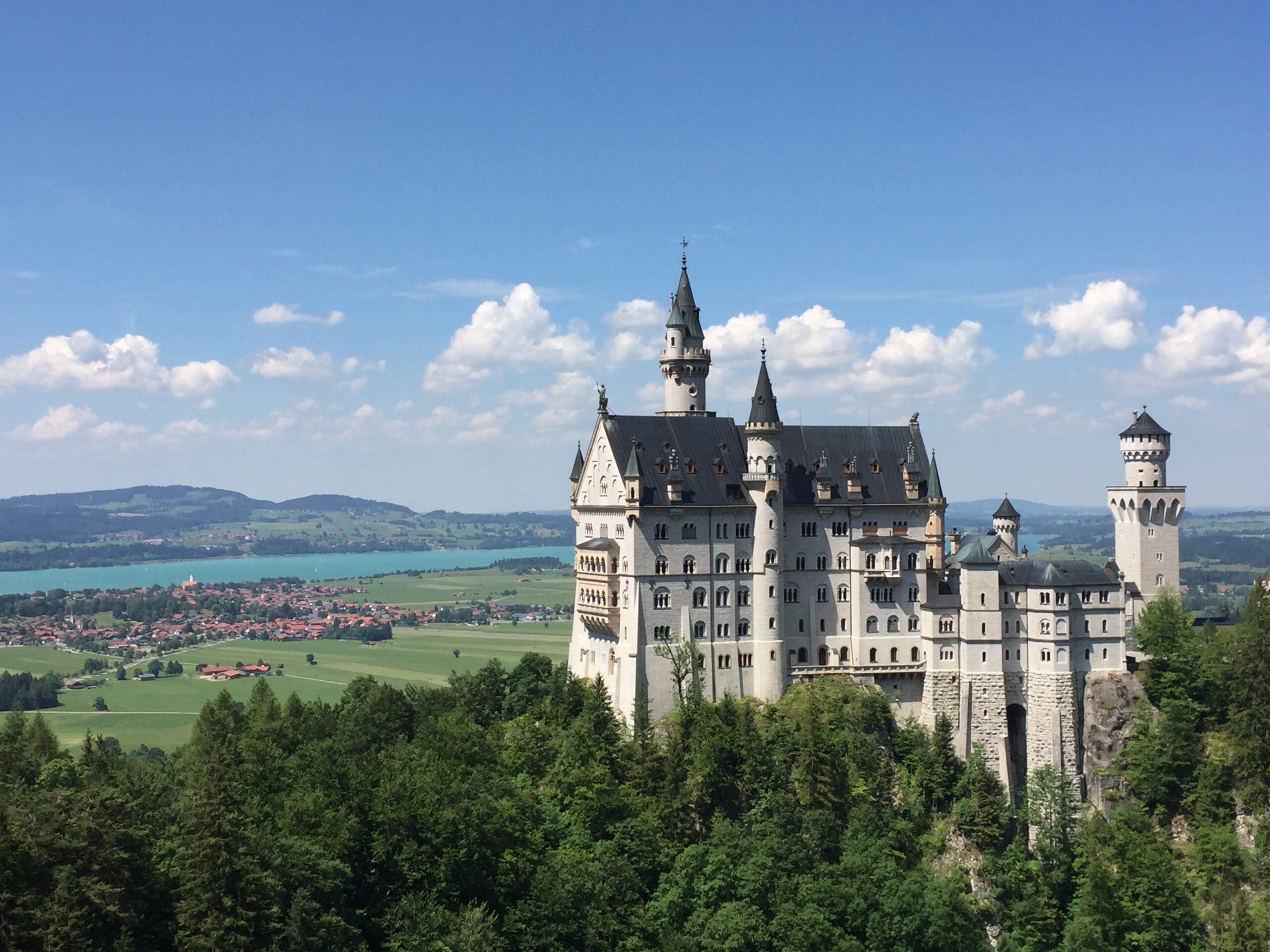DAY 13 – Friday, July 5, 2019 – Innbruck >> Wieskirche >> Neuschwanstein >> Fussen
After another breakfast buffet at Hotel Grauer Bar, the bus took us to an unplanned stop: Oberammergau where the passion play is performed every ten years. You must be born there and live there for at least 20 years to earn a part. Unfortunately, it was early and nothing was really open when were in Oberammergau.
The first Oberammergau performance of the Passion Play was in 1634 on a simple wooden platform in the cemetery. In 1830, the stage was built on the site of the present Passion Play Theater. In 1890, a permanent stage building was constructed. In 1900, the audience hall facing the open-air stage was built. The stage was given its present shape in 1930. In 2010, 500,000 spectators came from all over the world to watch the plays.
On June 14, 1738, Maria Lory, a farmer’s wife, saw moisture in the eyes of a statue portraying Jesus being scourged – and believed it to be tears. This led to the pilgrimage to the Church of the Scourged Savior in the Wies (meadow). From 1746 to 1754, Wieskirche Pilgrimage Church of the Scoured Savior was built at the foot of the Alps. It is a perfect example of Bavarian Rococo architecture. Around one million visitors come her every year from around the world – to look, marvel, pray, attend services and enjoy summer concerts. Wieskirche was added to the UNESCO World Heritage List in 1983.
I saw a traditional chalet when I walked out of the church and down the path was a small chapel.
For lunch, we had venison goulash or chicken, spaetzel, rice, clear soup with pancake noodles, and ice cream with apples, bananas, and cherries. Dick dropped a currant sauce covered pear on his lap, but it miraculously bounced off the seat between his legs and landed on the floor without touching his pants.
We saw Hohenschwangau Castle on our drive into the parking lot of Neuschwanstein Castle (New Swanstone Castle).
King Maximillan II acquired Hohenschwangau Castle, seat of the knights of Schwangau in the Middle Ages and rebuilt it in the Gothic Style in 1832. Ludwig II was born here in 1845 and developed a passion for the Middle Ages.
Vladya led some of us on a shortcut where we hiked to the bridge to get a great view of the Neuschwanstein Castle. Barbara and I hiked up a little further to a platform where a couple of girls had climbed out on limbs to get their photos taken. It was horribly frightening to watch them. On the walk from the bridge to the castle, Barbara and I both bought a small painting from an artist.
The tour of the Neuschwanstein Castle was OK. It looks like it was built in medieval times, but it’s only about 150 years old. Crazy King Ludwig spent 17 years building it until his mysterious death. The original decorations are amazing – murals, wood carvings, mosaic floors. The family halted construction after his death.
Ludwig II was 19 when he became king of Bavaria in 1864. Two years later, he was forced to accept the defeat and domination of his country by Prussia. No longer a sovereign leader, he created his own alternative world where he could live as a king of the Middle Ages. He enjoyed art, music, architecture, and preferred living in seclusion. He never married and struggled his entire life to resist his homosexual desires. In 1869, Ludwig II commissioned the construction of a medieval style castle on a rugged hill above the village of Hohenschwangau near Fussen in south Bavaria as a retreat and in honor of Richard Wagner (a 19th century composer, director, and conductor). The Gateway Building was completed in 1873 and served as Ludwig II’s primary residence. Although a monument to the medieval culture he revered and wanted to imitate, the castle was equipped with the latest technology of the time. Ludwig II paid for the palace out of his personal fortune and by means of extensive borrowing, rather than from Bavarian public funds. While he was deeply in debt, Ludwig II wanted to continue construction. The banks threatened to seize his property, and royal commissioners had him certified insane and committed to Berg Palace. Ludwig II (and his psychiatrist) died the next day, on June 13, 1886. According to the official report, Ludwig committed suicide by drowning himself. However, the autopsy indicated that there was no water in his lungs. It is rumored that Ludwig II and Dr. Bernhard von Gudden were shot. Construction of the castle was never finished. Prior to Ludwig II’s death no outsider was ever allowed to enter. On August 1, 1886 (six weeks after his death), it was named Neuschwanstein and opened to the public; since then more than 61 million people have visited the castle.
We drove to Europark Hotel near Fussen. There was a narrow canyon the bus had to maneuver through. An ambulance was trying to get out from the opposite direction; it backed down to let us through.
EuroPark Hotel is located on the River Lech in a region called Ostallgaeu (the land of castles and lakes). Fussen (population 15,500) is a Bavarian town, one kilometer from the Austrian border.
For dinner, we had salad bar, pork steak, potato dumplings, cabbage, and apple strudel in cream sauce.
After dinner, Barbara and I walked to a cavern across a bridge and back down by the river to other hotel bars and back.
What’s the best castle you’ve ever visited or dream of visiting? Where is it located? What makes it so special?

0 Comments